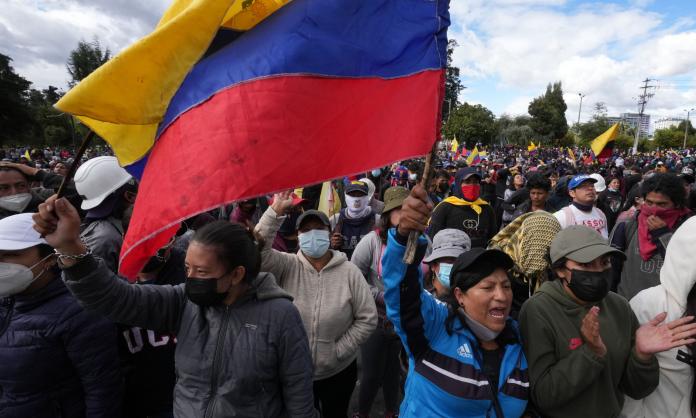After eighteen days of mass protests, an “agreement for peace” was reached between the Ecuadorian government and leading social organisations on 30 June to return stability to the country. The protests were in response to President Guillermo Lasso’s plan to cut fuel subsidies and were led by the Confederation of Indigenous Nationalities of Ecuador (CONAIE), an umbrella organisation of various groups with a history of leading rebellions that have ousted several presidents.
The fuel hike proposed by Lasso, a former banker elected last year, was part of a wider austerity package as he negotiates a new loan with the International Monetary Fund. But in the third year of a pandemic that has killed more than 35,000 people, and in the middle of a deep cost-of-living crisis, the Ecuadorian people responded with force to CONAIE’s call for an indefinite mobilisation to defeat the austerity package.
Protests rapidly spread across the country, including to the capital, Quito. The movement blocked roads, including one of the main highways, held large demonstrations and even arrested and detained police officers. In certain areas, it went even further. In the provinces of Tungurahua and Cotopaxi, protesters occupied the main government buildings, while in the city of Puyo they burned down a police station. For this, they were met with severe repression that took the lives of at least six people.
Despite the militancy of the protests, a weakness was the lack of participation of the organised working class. The main union confederation of the country, the United Workers’ Front, remained largely absent, rejecting calls for a general strike. There were, however, limited forms of industrial action, such as by transport and university workers in Quito and other cities. This lack of large-scale, coordinated industrial action contrasts starkly to a similar protest wave in 2019, when it was a prominent feature.
The 2019 rebellion began under almost identical circumstances. Then-President Lenín Moreno announced a fuel price hike as part of negotiations for an IMF loan, causing a genuinely popular uprising. Although it was again led by CONAIE, the working class in Quito played the key role by paralysing the country with a general strike. The movement then reached nearly insurrectionary levels when protesters stormed and occupied the National Assembly, causing the government to abandon the capital and move to the coastal city of Guayaquil.
Despite defeating the fuel hikes, the 2019 rebellion was only a partial victory. While it achieved its immediate goal, as the protesters became more confident, their demands grew to include the ouster of the government and the installation of a “People’s Assembly”.
But the conservative leaders of the unions and especially of CONAIE pulled back. Just as the more radical demands were being raised, CONAIE was quick to strike a deal with the government to wind up the protests and declare victory. Having literally abandoned the seat of government and being in an extremely weak position, Moreno was quick to oblige CONAIE’s more conservative demands. The CONAIE leaders, realising that if the movement was to continue radicalising they might lose control over it, were also inclined to bring the government back from the brink.
Despite the 2022 rebellion following a very similar path, it was never going to reach the same level without the participation of the urban working class. Also, the CONAIE leaders wanted to put an end to the movement far earlier than in 2019. This time, they had no desire to see a repeat of protesters occupying the National Assembly and a government on the verge of collapse. Instead, they were content with a US$0.15 reduction in the fuel price.
The rebellions of 2019 and 2022 are part of a long history in Ecuador of working-class and indigenous people defending their rights and living standards against austerity. In fact, such rebellions have been more the rule than the exception. Between 1997 and 2005, three presidents were ousted through mass social protests in response to proposed austerity measures.
The country experienced a brief lull after leftist President Rafael Correa was elected in 2006 as part of the so-called pink tide—when a series of left-wing governments won office in Latin America and oversaw varying degrees of wealth redistribution towards the working class.
However, in almost all pink tide countries, when the commodities boom of the 2000s came to an end, redistribution was replaced by austerity and repression and led to the return of right-wing governments. In Ecuador, CONAIE quickly turned from friend to foe of Correa. Since then, the working class and indigenous movement have defeated two austerity attempts by successive governments.
Today, both the ruling class and working class of Ecuador find themselves at something of an impasse. The ruling class for decades has been unable to defeat the indigenous movement and the urban workers. It wants to do so to revive its resource-extraction economy. The working class, for its part, shows a rarely matched militancy, radicalism and persistence but is ultimately hamstrung by its reformist leadership.
One welcome outcome of the 2022 rebellion is that the left wing of CONAIE has been strengthened and the right wing weakened. CONAIE has an affiliated political party called Pachakutik, with 27 members in the National Assembly. Divisions on the left between Correa’s bloc and Pachakutik, which represents the right wing of CONAIE, led to Pachakutik forming an alliance to help elect Lasso instead of Correa’s favoured candidate in the second round of last year’s elections.
Throughout the rebellion, Pachakutik politicians remained firmly committed to parliamentary procedures to end the crisis. Even when a parliamentary vote was held on 28 June to oust Lasso, two of the party’s members abstained. This contrasted starkly with the role of the CONAIE left wing, which was quick to call for mass protests, and sustained them for nearly three weeks.
But even the left wing of CONAIE has proven itself to be full of conciliators. To take things forward, when the next austerity package inevitably comes, the moderates will need to be sidelined.










